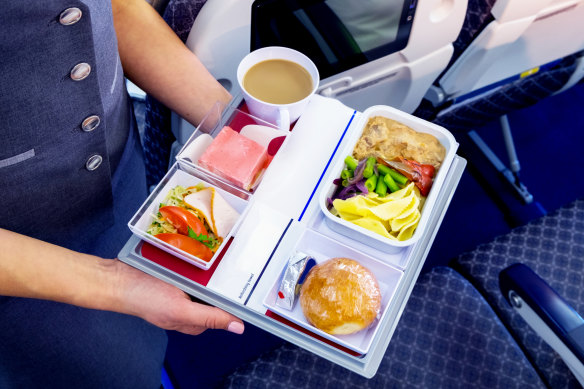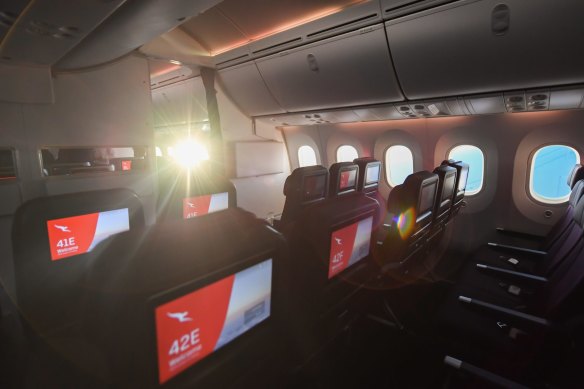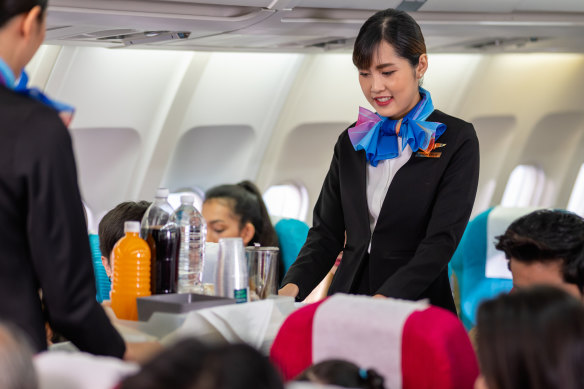Tuck in or skip: When is the best time to eat on a long flight?
When Melbourne-based Pip Valder boarded an Emirates flight to London last April at the wearisome time of 3.30am, she was hit with a familiar conundrum: should she try to get some sleep immediately, or wait until meals are served and avoid the inevitable disturbance?
“I didn’t know the likely timing of any meal, nor what would be offered; I was at a bit of a loss,” the 59-year-old project manager says.

The timing of meals on planes is becoming more important due to the development of ultra-long-haul flights. Credit: iStock
Each subsequent leg of the journey (her flight stopped in Singapore and Dubai on the way to the United Kingdom) was the same – cabin crew never announced meal timings, and she never really knew whether she should get some shut-eye or push through. It got her thinking: why don’t all airlines offer up this information and take one element of uncertainty out of the long-haul slog?
“For families travelling with children, it might be extra helpful,” she says.
Valder’s certainly not alone in her frustration. The meal-versus-rest debate is a mainstay topic of frequent flyers, and with the next phase of ultra-long-haul air travel fast approaching, meal timings in the air have never been more topical.
So, is there an ideal time to eat on a long-haul flight? This answer, of course, depends on the intended outcome. Are you eating for optimal health, energy or to lessen the overall effects of jet lag?
Times are a-changing
With Australian travellers staring down the barrel of 20-hour non-stop services in coming years, the physical toll of intercontinental travel continues to be a key focus for full-service airlines – and the on-board meal will increasingly play a role in offsetting travel fatigue and jet lag.
Part of why we know this is thanks to Qantas, who’ve been making great strides in this field of research. Ahead of the launch of its 20-hour Paris, New York and London non-stop services from Sydney and Melbourne in late-2025, the carrier has been working with scientists on ways to address jet lag through its on-board program, Project Sunrise. And one of the key findings has been around the timing of meals – specifically, how service times can be utilised to shift your body clock for the next time zone.
“While the advice is to not eat when you’re not hungry [in the air], there’s a trade-off – having a meal and eating might also be a cue to help you get into the local time at your destination,” says Dr Yu Sun Bin, an epidemiologist and circadian rhythm researcher at the University of Sydney, who has worked on Project Sunrise.

Qantas’ Project Sunrise flights will see passengers spend up 20 hours on board in long-haul flights from Australia’s east coast non-stop to London or New York.
Altering meal timings is actually less about when you eat, and more about controlling the level of daylight you’re exposed to.
“As part of Project Sunrise, we’ve experimented with aligning the meal times with when we want people to be awake and asleep on the plane – and they’re also aligned with when we want people to get light exposure,” he says.
The idea is to trick your natural circadian rhythm – the internal timekeeper that messages the body to produce hormones that control everyday functions such as appetite, sleep, alertness and temperature – into realignment.
Grub’s up
Typically, airlines serve meals right after take-off and then again towards the end of a flight. Some full-service carriers such as Air New Zealand and Qantas also offer refreshments in between, depending on the length of flight and time of day (many overnight services will skip this courtesy, with most passengers opting for a kip instead). Carriers may offer greater dining flexibility to passengers in its premium cabins – Etihad has a “dine any time” service that lets flyers decide how they want to spend their time on board.

Cabin crew typically serve meals shortly after take-off and before landing.Credit: iStock
Some airlines announce meal service timings at the beginning of the flight though this practice can vary, as in Valder’s case.
Generally, carriers don’t time meals according to the onward destination, or at least it’s not the done thing – yet. Qantas has stated previously it’s looking into adjusting its on-board meal timings as part of Project Sunrise, among other anti-jet lag measures, though more research is needed – and if this is adopted, it isn’t likely to take effect until 2025.
While the act of eating does send a signal to your internal timekeeping mechanisms, using meal timings to create the right conditions for strategic light exposure is a far more effective approach.
“The best tool for reducing jet lag is optimising the timing of light. Light is the stimulus that resets our circadian rhythms,” says Dr Erin Flynn-Evans, director of the NASA Ames Research Center’s Fatigue Countermeasures Laboratory.
Flynn-Evans – who has extensive experience in the effects of circadian desynchrony in settings such as those experienced by astronauts, airline pilots and shift workers – believes light is the quickest and most effective way to address circadian misalignment. More so than eating.
“When you travel across time zones, adaptation to the new time zone happens fastest when light is timed appropriately. The simple rule of thumb – getting sufficient daytime lighting is probably the easiest tip for a very complicated process,” says Flynn-Evans. It’s why experts in circadian misalignment and jet lag widely recommend seeking sunlight in the new destination.
Should you skip the inflight meal?
Delta Air Lines gives its business class passengers the option to “Skip First Meal Service” in its pre-selection app. Introducing the option has apparently been a game-changer in terms of the reduction of cabin waste, according to the carrier, though there are many more great arguments for skipping – jet lag being chief among them.
In a nutshell, forcing yourself to eat at a time that your body thinks it should be asleep can come with some unwanted side effects.
“Our body clock is telling the gut when it should be asleep and when it should be awake, or at its optimum, peak performance for metabolising food,” explains Melissa Adamski, a dietitian specialising in travel health from Nutted Out Nutrition in Melbourne.
A heavy meal at a time your body thinks it’s midnight, say, could even bring on gastro-like symptoms.
“Circadian rhythms can affect the gastric enzymes that are released, gut motility and nutrient absorption,” says Adamski. And this is on top of the common bloating experienced due to the low pressured cabin environment.
“That can then affect our sleep because we might be awake with gut issues, abdominal pain, or diarrhoea.”
For passengers trying to shift their circadian rhythm through meal timings, Dr Bin urges a gentler approach.
“Have a light meal to adapt to local time— don’t have a heavy meal, particularly if you’re not hungry,” says Bin.
Meal timings risk for frequent flyers
When your body believes it’s asleep, a lot of its processes slow down, including digestion and metabolism. This can have some unforeseen negative implications for frequent flyers.
As a dietitian specialising in travel health, Adamski regularly works with business travellers on how they can reduce the inherent health risks that come with eating meals out of sync to their natural circadian rhythms.
“When we eat large amounts of carbohydrates at night, we get larger rises in blood glucose levels than what we would see for that exact same meal eaten during the daytime,” she explains.
Over time, this can heighten the risk of developing type 2 diabetes due to the disruption in how nutrients are being metabolised.
Adamski recommends eating lighter meals and avoiding refined carbohydrates and ultra-processed foods where possible to reduce the impact to blood sugar level, as it will be magnified at night. She also suggests shifting your eating times in the days leading up to an overseas trip, and a few days after, to support metabolic changes in the body.
Sign up for the Traveller newsletter
The latest travel news, tips and inspiration delivered to your inbox. Sign up now.